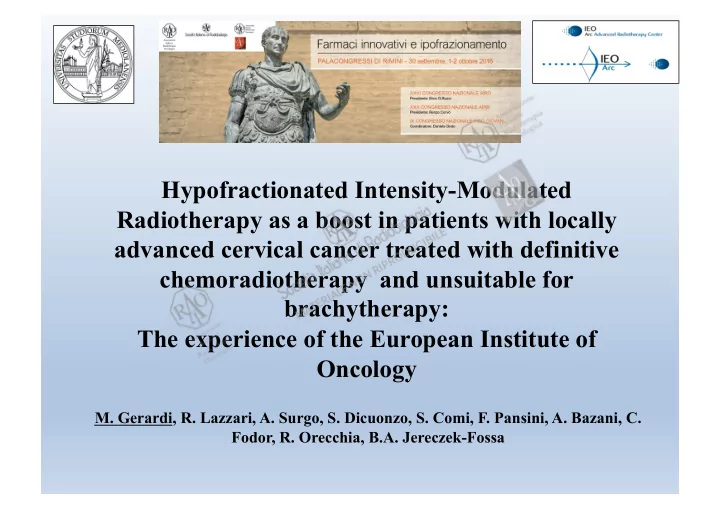

Hypofractionated Intensity-Modulated Radiotherapy as a boost in patients with locally advanced cervical cancer treated with definitive chemoradiotherapy and unsuitable for brachytherapy: The experience of the European Institute of Oncology M. Gerardi, R. Lazzari, A. Surgo, S. Dicuonzo, S. Comi, F. Pansini, A. Bazani, C. Fodor, R. Orecchia, B.A. Jereczek-Fossa
Brachytherapy as a boost the gold standard for cervical cancer patients treated With definitive radiochemotherapy - About 20% of cervical cancer patients are not good candidates for brachytherapy AIMS To evaluate: - toxicity profile - efficacy Hypofractionated IMRT boost after external beam radiation therapy (EBRT) in patients with cervical cancer judged unsuitable for brachytherapy boost (BRT).
2013 ¡
Patients’ and tumors’ characteristics - 24 pts with cervical cancer treated between June 2012 and April 2016 at EIO - Median age: 56 years - Hystology: 22 SCC, 1 adk, FIGO Staging 10 ¡ 1 not available 5 ¡ 5 ¡ 2 ¡ 1 ¡ 1 ¡ IB1 ¡ IB2 ¡ IIB ¡ IIIB ¡ IVA ¡ IVB ¡
Treatment characteristics All pts received IMRT-EBRT IGRT - primary tumor - regional nodes - paraaortic nodes if indicated (12 pts) Total dose of 43.2-50,4 Gy (1.8 Gy/fr in all cases) - Concomitant chemotherapy was performed in 21 pts - 2 pts received neoadjuvant chemotherapy
Brachitherapy excluded for: - ¡ Bladder/rectal/ureteral infiltration in 7 pts - Uterine fibromas in 4 pts - Low compliance in 5 pts - CT-RT related Toxicity in 3 pts - Persistence/progression disease in 3 pts - Comorbidities in 1 pt - High risk of contamination in operating room in 1 pt
Pelvic MRI at the end of EBRT GTV CTV (initial volume) PTV (CTV + 3/5 mm) Brainlab-Vero System
BOOST Image-guided IMRT including the cervix +/- parametrium - 5 or 7 fields - Total dose of 20-25 Gy - Median dose per fraction of 5 Gy (range: 2.5–8 Gy) - Median overall treatment time: 79 days CONSTRAINTS Volume ¡ Dose ¡ PTV ¡ V90 ¡ > ¡95% ¡ prescrip6on ¡dose ¡ Bladder ¡ ¡ 2 ¡cc ¡ < ¡80% ¡ prescrip6on ¡dose ¡ 1 ¡cc ¡ < ¡80% ¡ prescrip6on ¡dose ¡ Rectum ¡ ¡ 2 ¡cc ¡ < ¡70% ¡ prescrip6on ¡dose ¡ 1 ¡cc ¡ < ¡90%% ¡ prescrip6on ¡dose ¡ Small ¡bowel ¡ 2 ¡cc ¡ < ¡90%% ¡ prescrip6on ¡dose ¡
Toxicity ( CTCAE scale v 4.03) ACUTE TOT G0 G1 G2 G3 G4 PTS GI 24 18 5 1 0 0 No patients developed gastrointestinal or (75%) (20%) (5%) genitourinary acute toxicity superior to Grade 2 GU 24 20 3 0 0 1 (83%) (12%) (5%) CHRONIC 10 pts NED with follow-up > 6 months 7 pts GU G0 8 pts GI G0 1 pt GI G1
Tumor control 21/ 24 pts Median Follow-up = 13 months Stage NED AWD Local Disease Distant Disease IB1 1 - - IB2 1 - - 67% local control IIB 4 1 - IIIB 1 1 - IVA 4 1 58% local control in stage IV IVB 1 - 2 4 = 12 pts = 9 pts 57% 43%
CRITICISMS: - Small cohort - Short Follow-up - Heterogeneity of population (FIGO Stage) BUT Homogeneus RT treatment Conclusion Non invasive therapy Good local control Low impact on quality of life In pts unsuitable for brachytherapy
Thanks for the attention Thanks for the attenti
Recommend
More recommend